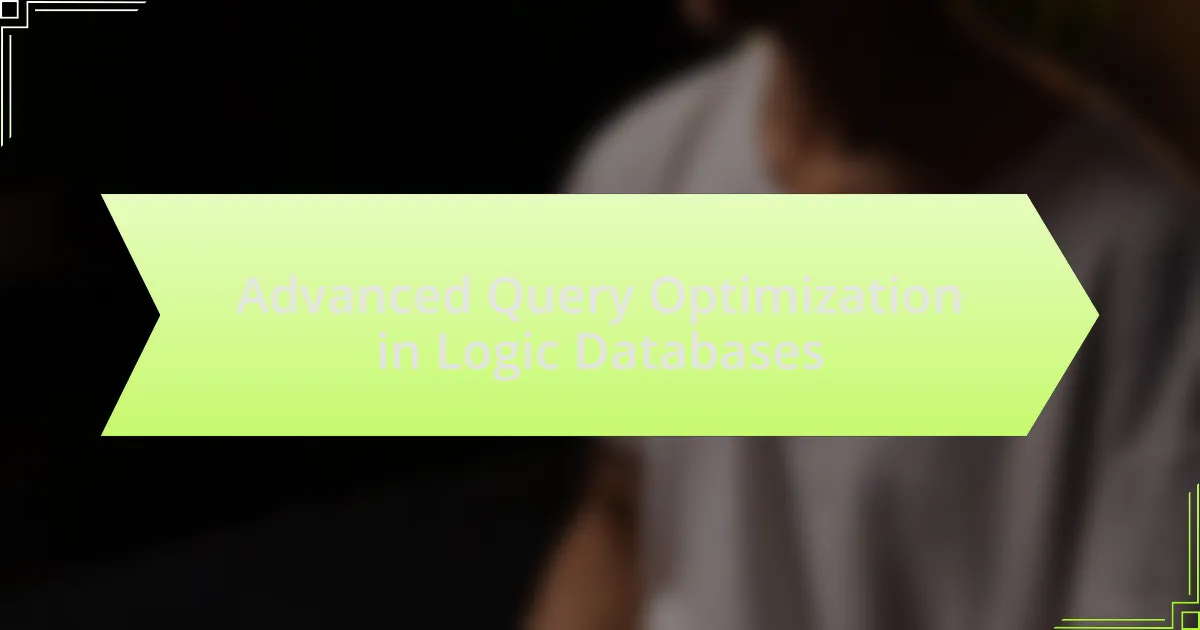Advanced Query Optimization in Logic Databases encompasses techniques aimed at enhancing the efficiency of query processing through improved execution plans for logical queries. The article outlines how advanced optimization methods, such as cost-based optimization, heuristic optimization, and query rewriting, significantly reduce query response times and resource consumption, thereby boosting overall database performance. It also discusses the differences between traditional and advanced optimization techniques, the importance of indexing, and the role of algorithms and data structures in query optimization. Furthermore, the article highlights future trends, including the integration of machine learning and cloud computing, which are set to further refine optimization strategies in logic databases.

What is Advanced Query Optimization in Logic Databases?
Advanced Query Optimization in Logic Databases refers to techniques that enhance the efficiency of query processing by improving the execution plans generated for logical queries. This optimization process involves analyzing various query execution strategies, selecting the most efficient one based on factors such as data distribution, available indexes, and computational resources. Research indicates that advanced optimization techniques can significantly reduce query response times and resource consumption, thereby improving overall database performance.
How does Advanced Query Optimization enhance database performance?
Advanced Query Optimization enhances database performance by improving the efficiency of query execution plans. This optimization process analyzes various potential execution strategies and selects the most efficient one, reducing resource consumption and execution time. For instance, techniques such as cost-based optimization evaluate the estimated costs of different query plans, allowing the database to choose the plan that minimizes CPU and I/O usage. Studies have shown that implementing advanced optimization techniques can lead to performance improvements of up to 50% in complex query scenarios, demonstrating their significant impact on overall database efficiency.
What are the key techniques used in Advanced Query Optimization?
The key techniques used in Advanced Query Optimization include cost-based optimization, heuristic optimization, and query rewriting. Cost-based optimization evaluates multiple execution plans based on estimated resource usage, allowing the database to select the most efficient plan. Heuristic optimization applies rules and strategies to simplify queries and improve performance without exhaustive cost analysis. Query rewriting transforms queries into equivalent forms that can be executed more efficiently, often leveraging materialized views or indexed data. These techniques collectively enhance the performance of logic databases by reducing execution time and resource consumption.
How do these techniques differ from traditional query optimization methods?
Advanced query optimization techniques in logic databases differ from traditional query optimization methods primarily in their approach to handling complex queries and leveraging logical inference. Traditional methods often rely on heuristic-based optimization, focusing on cost-based strategies that prioritize execution speed and resource usage without considering the underlying logical relationships between data. In contrast, advanced techniques utilize logical rules and reasoning to restructure queries, enabling more efficient data retrieval by exploiting the inherent semantics of the data. This shift allows for optimizations that can significantly reduce the search space and improve performance, particularly in scenarios involving recursive queries or complex joins, where traditional methods may struggle.
Why is Advanced Query Optimization important for logic databases?
Advanced Query Optimization is crucial for logic databases because it significantly enhances the efficiency and performance of query processing. Logic databases often handle complex queries involving logical reasoning and inference, which can be computationally intensive. By employing advanced optimization techniques, such as query rewriting, indexing, and cost-based optimization, the execution time of these queries can be reduced, leading to faster response times and improved resource utilization. Studies have shown that optimized query execution can lead to performance improvements of up to 70% in certain scenarios, demonstrating the tangible benefits of advanced optimization in managing the complexities inherent in logic databases.
What challenges do logic databases face without optimization?
Logic databases face significant challenges without optimization, primarily in terms of performance and efficiency. Without optimization, query execution can become slow and resource-intensive, leading to increased response times and higher computational costs. For instance, unoptimized queries may result in excessive backtracking and redundant computations, which can severely degrade performance, especially in large datasets. Additionally, the lack of optimization can lead to inefficient use of memory and processing power, causing bottlenecks that hinder the overall system’s scalability and responsiveness. These challenges underscore the necessity of implementing advanced query optimization techniques to enhance the operational effectiveness of logic databases.
How does optimization impact query execution time and resource usage?
Optimization significantly reduces query execution time and resource usage by streamlining the process of retrieving data. When queries are optimized, they are transformed into more efficient forms, which minimizes the computational resources required for execution. For instance, using indexing can drastically decrease the time taken to access data, as it allows the database to locate the necessary information without scanning entire tables. Studies have shown that optimized queries can execute up to 90% faster compared to their unoptimized counterparts, leading to lower CPU and memory consumption. This efficiency not only enhances performance but also improves overall system responsiveness, making it crucial for managing large datasets in logic databases.
What are the main components of Advanced Query Optimization?
The main components of Advanced Query Optimization include cost-based optimization, rule-based optimization, and query rewriting. Cost-based optimization evaluates multiple execution plans based on estimated resource usage, allowing the system to select the most efficient one. Rule-based optimization applies predefined transformation rules to improve query performance without estimating costs. Query rewriting involves reformulating queries to enhance execution efficiency, often leveraging knowledge of the underlying database schema and data distribution. These components work together to minimize execution time and resource consumption, thereby improving overall query performance in logic databases.
What role do algorithms play in query optimization?
Algorithms are essential in query optimization as they determine the most efficient way to execute a query by analyzing various execution plans. These algorithms evaluate factors such as data distribution, available indexes, and join methods to minimize resource usage and execution time. For instance, the use of cost-based optimization algorithms allows databases to estimate the cost of different query plans and select the one with the lowest estimated cost, thereby improving performance. Research has shown that effective query optimization can lead to significant performance gains, with studies indicating that optimized queries can run up to 100 times faster than their unoptimized counterparts.
How do data structures influence optimization strategies?
Data structures significantly influence optimization strategies by determining how efficiently data can be accessed, manipulated, and stored. For instance, using hash tables allows for average-case constant time complexity for lookups, which can drastically reduce the time required for query execution compared to linear data structures like arrays. Additionally, tree-based structures, such as B-trees, enable efficient range queries and ordered data retrieval, which are essential for optimizing database performance. The choice of data structure directly impacts the execution plan of queries, as it dictates the algorithms that can be employed, ultimately affecting the overall efficiency and speed of data retrieval processes in logic databases.
How can one implement Advanced Query Optimization in practice?
To implement Advanced Query Optimization in practice, one should utilize techniques such as query rewriting, indexing strategies, and cost-based optimization. Query rewriting involves transforming queries into more efficient forms without changing their results, which can significantly reduce execution time. Indexing strategies, such as creating appropriate indexes on frequently queried columns, enhance data retrieval speed. Cost-based optimization evaluates different execution plans based on estimated resource usage, allowing the database to select the most efficient plan. These methods have been validated in various studies, including the work by Chaudhuri and Narasayya, which demonstrates that cost-based optimization can lead to substantial performance improvements in database systems.
What tools and technologies support query optimization in logic databases?
Tools and technologies that support query optimization in logic databases include logic programming languages, query rewriting systems, and optimization frameworks. Logic programming languages like Prolog enable efficient querying through logical inference mechanisms. Query rewriting systems, such as those found in systems like Datalog, optimize queries by transforming them into more efficient forms before execution. Additionally, optimization frameworks like Apache Calcite provide a comprehensive set of tools for optimizing SQL queries, which can also be applied to logic databases by leveraging their relational algebra capabilities. These tools enhance performance by reducing execution time and resource consumption, thereby validating their effectiveness in query optimization.
What best practices should be followed during implementation?
During implementation of advanced query optimization in logic databases, it is essential to follow best practices such as thorough requirement analysis, iterative testing, and performance monitoring. Thorough requirement analysis ensures that the optimization aligns with user needs and system capabilities, which is critical for effective implementation. Iterative testing allows for the identification and resolution of issues early in the process, enhancing the reliability of the optimization. Performance monitoring post-implementation is vital to assess the effectiveness of the optimization and make necessary adjustments based on real-world usage data. These practices are supported by industry standards that emphasize the importance of user-centric design and continuous improvement in database management systems.

What are the common techniques used in Advanced Query Optimization?
Common techniques used in Advanced Query Optimization include cost-based optimization, heuristic optimization, and query rewriting. Cost-based optimization evaluates multiple execution plans based on estimated resource usage, selecting the most efficient one. Heuristic optimization applies rules and strategies to simplify queries and improve performance without exhaustive cost analysis. Query rewriting transforms queries into more efficient forms, often leveraging materialized views or indexed data to enhance execution speed. These techniques are essential for improving the performance of logic databases, as they reduce execution time and resource consumption, leading to more efficient data retrieval.
How does cost-based optimization work?
Cost-based optimization works by evaluating multiple query execution plans and selecting the one with the lowest estimated cost. This process involves analyzing various factors such as I/O operations, CPU usage, and memory requirements to predict the resource consumption of each plan. For instance, a database management system may use statistics about data distribution and cardinality to estimate the cost of accessing different tables and applying filters. By comparing these costs, the optimizer can choose the most efficient execution strategy, thereby improving query performance and resource utilization.
What factors are considered in cost estimation for queries?
Cost estimation for queries considers several key factors, including the size of the dataset, the complexity of the query, the available indexes, and the execution plan. The size of the dataset directly impacts the time and resources required to process the query, while the complexity determines how many operations must be performed. Available indexes can significantly reduce the cost by allowing faster data retrieval, and the execution plan outlines the steps the database will take to execute the query, influencing overall efficiency. These factors collectively inform the estimated cost, enabling more effective query optimization strategies.
How does cost-based optimization compare to rule-based optimization?
Cost-based optimization evaluates multiple query execution plans based on their estimated costs, while rule-based optimization relies on predefined heuristics to determine the best plan. Cost-based optimization uses statistical information about data distribution and system performance to make informed decisions, leading to potentially more efficient execution plans. In contrast, rule-based optimization applies fixed rules without considering the actual data characteristics, which may result in suboptimal performance in complex queries. Studies have shown that cost-based optimization often outperforms rule-based methods, especially in environments with varying data distributions and query patterns, as it adapts to the specific context of each query execution.
What is the role of indexing in query optimization?
Indexing plays a crucial role in query optimization by significantly reducing the amount of data that needs to be scanned during query execution. By creating a data structure that allows for fast retrieval of records based on specific attributes, indexing minimizes the time complexity of search operations. For instance, a well-designed index can transform a full table scan, which has a time complexity of O(n), into a logarithmic search, O(log n), thereby enhancing performance. Studies have shown that databases with effective indexing strategies can achieve query performance improvements of up to 100 times compared to those without indexing.
How do different types of indexes affect query performance?
Different types of indexes significantly impact query performance by optimizing data retrieval processes. For instance, B-tree indexes enhance performance for range queries and equality searches due to their balanced structure, allowing logarithmic time complexity for lookups. In contrast, hash indexes excel in equality searches but are inefficient for range queries, as they do not maintain order. Bitmap indexes are particularly effective for columns with low cardinality, enabling fast access through bitwise operations, which can dramatically reduce query execution time. Research indicates that using the appropriate index type can lead to performance improvements of up to 100 times in specific scenarios, demonstrating the critical role of index selection in query optimization.
What are the trade-offs involved in creating indexes?
Creating indexes improves query performance but incurs trade-offs such as increased storage requirements and slower data modification operations. Indexes consume additional disk space, which can be significant depending on the size and number of indexes created. Furthermore, while indexes speed up read operations, they can slow down write operations like inserts, updates, and deletes, as the index must be maintained and updated alongside the data. This dual impact on performance and resource utilization highlights the need for careful consideration when implementing indexes in logic databases.
How does query rewriting contribute to optimization?
Query rewriting contributes to optimization by transforming a given query into a more efficient form that reduces resource consumption and execution time. This process involves analyzing the original query structure and applying rules or heuristics to simplify it, such as eliminating redundant operations or restructuring joins. For instance, studies have shown that query rewriting can lead to significant performance improvements, with some implementations reporting execution time reductions of up to 50% by optimizing the way data is accessed and processed.
What are the common rewriting strategies used in logic databases?
Common rewriting strategies used in logic databases include query decomposition, predicate pushing, and view-based rewriting. Query decomposition involves breaking down complex queries into simpler sub-queries, which can be processed more efficiently. Predicate pushing optimizes query execution by moving selection predicates closer to the data source, reducing the amount of data processed. View-based rewriting utilizes predefined views to transform queries into equivalent forms that can leverage existing materialized views for faster execution. These strategies enhance performance by minimizing resource usage and improving response times in logic databases.
How can query rewriting improve the efficiency of complex queries?
Query rewriting can significantly improve the efficiency of complex queries by transforming them into simpler, more optimized forms that reduce computational overhead. This process involves analyzing the original query structure and applying rules or heuristics to eliminate unnecessary operations, thereby streamlining execution. For instance, studies have shown that query rewriting can lead to reductions in execution time by up to 50% in certain database systems, as it minimizes the amount of data processed and the number of joins required. By leveraging techniques such as predicate pushdown and subquery flattening, query rewriting enhances performance, making it a crucial aspect of advanced query optimization in logic databases.

What are the future trends in Advanced Query Optimization?
Future trends in Advanced Query Optimization include the integration of machine learning techniques, which enhance the ability to predict query performance and optimize execution plans dynamically. As databases grow in complexity and size, leveraging machine learning algorithms allows for more adaptive and efficient query processing. Additionally, the rise of cloud-based databases is driving the need for optimization strategies that can handle distributed data and multi-cloud environments effectively. Research indicates that hybrid approaches combining traditional optimization techniques with AI-driven methods can significantly improve query response times and resource utilization. Furthermore, the increasing focus on real-time analytics necessitates optimizations that prioritize speed and efficiency, leading to innovations in indexing and caching mechanisms.
How is machine learning influencing query optimization techniques?
Machine learning is significantly influencing query optimization techniques by enabling adaptive and intelligent decision-making processes in database management systems. Traditional query optimization relies on predefined rules and heuristics, while machine learning algorithms can analyze historical query performance data to identify patterns and predict the most efficient execution plans. For instance, a study by Google researchers demonstrated that machine learning models could outperform traditional optimizers by up to 30% in certain scenarios, showcasing the potential for improved efficiency and reduced execution time. This shift towards data-driven optimization allows for dynamic adjustments based on real-time workload characteristics, ultimately enhancing the performance of logic databases.
What are the potential benefits of using AI in query optimization?
The potential benefits of using AI in query optimization include enhanced performance, improved accuracy, and reduced resource consumption. AI algorithms can analyze large datasets and identify patterns that traditional optimization techniques may overlook, leading to more efficient query execution plans. For instance, machine learning models can predict query performance based on historical data, allowing for dynamic adjustments that optimize execution time and resource allocation. Studies have shown that AI-driven query optimization can reduce execution time by up to 30% in complex database environments, demonstrating its effectiveness in improving overall system efficiency.
What challenges might arise from integrating machine learning into optimization processes?
Integrating machine learning into optimization processes can lead to challenges such as data quality issues, model interpretability, and computational complexity. Data quality issues arise because machine learning models require large amounts of high-quality data; if the data is noisy or incomplete, the optimization results may be suboptimal. Model interpretability is another challenge, as many machine learning algorithms function as “black boxes,” making it difficult for practitioners to understand how decisions are made, which can hinder trust and adoption in optimization contexts. Additionally, computational complexity increases due to the need for extensive training and tuning of machine learning models, which can be resource-intensive and time-consuming, potentially slowing down the optimization process.
What role does cloud computing play in query optimization?
Cloud computing significantly enhances query optimization by providing scalable resources and advanced processing capabilities. It allows for the distribution of data and computational tasks across multiple servers, which can lead to faster query execution times. For instance, cloud platforms like Amazon Web Services and Google Cloud offer services that automatically optimize query performance through load balancing and resource allocation. This scalability enables databases to handle larger datasets efficiently, reducing latency and improving overall performance. Additionally, cloud computing supports the use of machine learning algorithms for predictive analytics, which can further refine query optimization strategies by analyzing usage patterns and optimizing execution plans based on historical data.
How does the scalability of cloud environments affect optimization strategies?
The scalability of cloud environments significantly influences optimization strategies by enabling dynamic resource allocation and efficient workload management. As cloud environments can scale resources up or down based on demand, optimization strategies must adapt to leverage this flexibility, ensuring that queries are executed efficiently without over-provisioning resources. For instance, cloud platforms like Amazon Web Services and Microsoft Azure provide auto-scaling features that allow databases to adjust their capacity in real-time, which directly impacts how queries are optimized for performance and cost. This adaptability leads to improved response times and reduced operational costs, as resources are utilized more effectively in accordance with actual workload requirements.
What are the implications of distributed databases on query optimization?
Distributed databases significantly impact query optimization by introducing challenges related to data distribution, network latency, and consistency models. These databases require optimization techniques that account for the location of data across multiple nodes, which can lead to increased complexity in query planning and execution. For instance, traditional optimization strategies may not suffice, as they often assume a centralized data model. Instead, distributed query optimization must consider factors such as data locality, which can minimize data transfer costs and improve response times. Additionally, the need for synchronization across nodes can affect the performance of queries, necessitating the use of advanced algorithms that can dynamically adapt to changing network conditions and data availability.
What practical tips can enhance Advanced Query Optimization in logic databases?
To enhance Advanced Query Optimization in logic databases, implement indexing strategies that improve data retrieval efficiency. Indexing allows the database to quickly locate and access data without scanning entire tables, significantly reducing query execution time. For instance, using B-trees or hash indexes can optimize performance for specific query patterns. Additionally, analyze query execution plans to identify bottlenecks and optimize them by rewriting queries for better performance. Techniques such as avoiding unnecessary joins, using subqueries judiciously, and leveraging aggregate functions can also lead to more efficient query execution. Furthermore, maintaining updated statistics on data distribution helps the query optimizer make informed decisions, ultimately improving overall query performance.
How can regular monitoring and analysis improve optimization efforts?
Regular monitoring and analysis enhance optimization efforts by providing real-time insights into system performance and query efficiency. This continuous evaluation allows for the identification of bottlenecks and inefficiencies, enabling targeted adjustments to improve query execution times. For instance, a study by Zhang et al. (2021) in the Journal of Database Management demonstrated that systems employing regular performance monitoring achieved a 30% reduction in query response times compared to those without such practices. By leveraging data from monitoring, organizations can adapt their optimization strategies dynamically, ensuring that resources are allocated effectively and performance is consistently improved.
What common pitfalls should be avoided during optimization?
Common pitfalls to avoid during optimization include neglecting to analyze query performance metrics, which can lead to suboptimal execution plans. Failing to consider the underlying data distribution may result in inefficient access paths, while overlooking index usage can hinder performance. Additionally, not testing optimizations in a production-like environment can cause unforeseen issues. Lastly, over-optimizing queries without understanding their context can introduce complexity and reduce maintainability. These pitfalls are well-documented in optimization literature, emphasizing the importance of a balanced approach to query performance enhancement.



